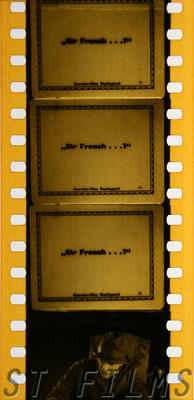|
Farsangi mámor
moving image document > frame scan
Title
Farsangi mámor (frame scan)
Description
Scanned section of the colour tinted nitrate fragment, which survived in the Deutsche Kinemathek's collection, originally produced to aid its identification via LOST FILMS. The scan shows one of the German-language "flash titles", which were frequently included by producers in prints or negatives of films intended for export abroad as reference points for foreign distributors to insert new full-length inter-titles. Titles can contain valuable clues for identifying unknown silent films - in this case, the reference to both one of the main characters (Sir French) and the production company (Corvin-Film). (Note: Inter-titles that bore a simple graphic design like this were often for simplicity's sake cut into prints directly as negatives. As no other printing element existed, the same negative material was cut into camera negatives as "flash titles", named as such because they measured usually only two or three frames. In order to join properly, the titles had to be horizontally reversed. In positives struck from these negatives, therefore, the text of the flash-titles appears back to front. The scan presented here has been adjusted so that the text can be read more effectively) Corvin Filmgyár, named after the Hungarian King Matthias Corvinus (1443-1490), was founded in the Transylvanian city of Kolozsvár (now Cluj-Napoca in Romania) in 1916 by Jenő Janovics (1872-1945). Janovics was then the director of the Hungarian National Theatre in Kolozsvár and a pioneering figure in the emerging Hungarian cinema. A second branch soon followed in the country's capital, Budapest, where the Corvin studio was built. In charge of the Budapest operation was a promising young director named Sándor Korda (1893-1956), who would later become world famous as Alexander Korda. Korda had started as a film critic at age 18 before becoming a director under Janovics' tutelage in Kolozsvár. In 1917 Janovics sold Corvin to Korda, who transferred all company operations to Budapest. Korda's high standards and ambition ensured a prolific output of consistently high quality films. Corvin productions of this time boasted some of Hungary's finest talents both behind and in front of the camera such as directors Korda, Sándor Antalffy and Márton Garas, writer László Vajda and actors Mihály Várkonyi, Antónia Farkas (who became Korda's first wife), Pál Lukács and Oszkár Beregi, all of whom would go on to have successful careers abroad. Significantly, Korda felt that Hungarian films could be made to be enjoyed by national and international audiences alike, an approach, which would earn him worldwide success and lasting recognition after he settled in Britain in the 1930s. The company managed to survive Korda's departure from Hungary in 1919 following the collapse of the short lived Hungarian Soviet Republic. The quality of Corvin's output, however, inevitably suffered as more and more of Hungary's best actors and technicians decamped abroad. 1919 also saw the lift on the ban of foreign imports that had been in effect since the war. The local production companies struggled to keep up with the influx of films from abroad and gradually films from major producing countries like America, France, Italy and Denmark came to dominate the market over home-grown offerings. Corvin soldiered on until 1926 when the company, like many others, went bankrupt and its studio was closed down (though the latter was later resurrected as the Hunnia Film Studio and the Mafilm Studios today still stand on its original location). Gyöngyi Balogh / Oliver Hanley, 06.12.2010 Selected literature (all links still active as of the publication date) * Gyöngyi Balogh, "History of the Hungarian Film, from the beginning until 1945," in Filmkultúra - a Magyar Nemzeti Filmarchívum online magazinja, 21.01.2001 * Gyöngyi Balogh, Bálint Zágoni (eds.), A kolozsvári filmgyártás képes története 1913-tól 1920-ig (An Illustrated History of Film Production in Cluj / Kolozsvár from 1913 to 1920), Cluj-Napoca: Filmtett Egyesület / Magyar Nemzeti Filmarchívum, 2009 * John Cunningham, "Jenö Janovics and Transylvanian Silent Cinema," in Catherine Portuges (Guest Ed.), Kinokultura, Special Issue 7: Hungarian Cinema, February 2008
Id number
SDK_00487-N_11
Related collections
Deutsche Kinemathek - Museum für Film und Fernsehen (is a part of) Magyar Nemzeti Filmarchívum / Hungarian National Film Archive (is a part of)
Collection category
film archive
Classification
moving image document > frame scan |
 |